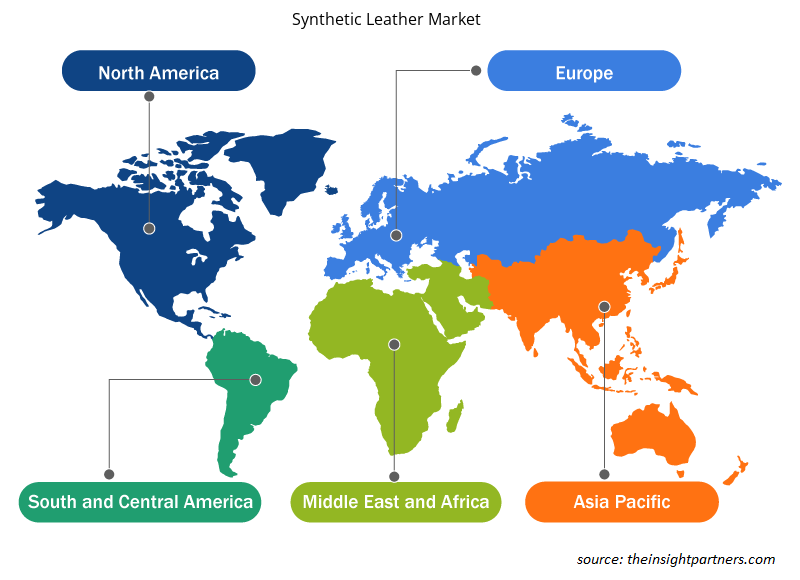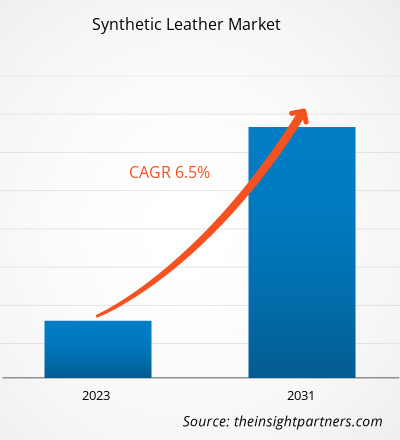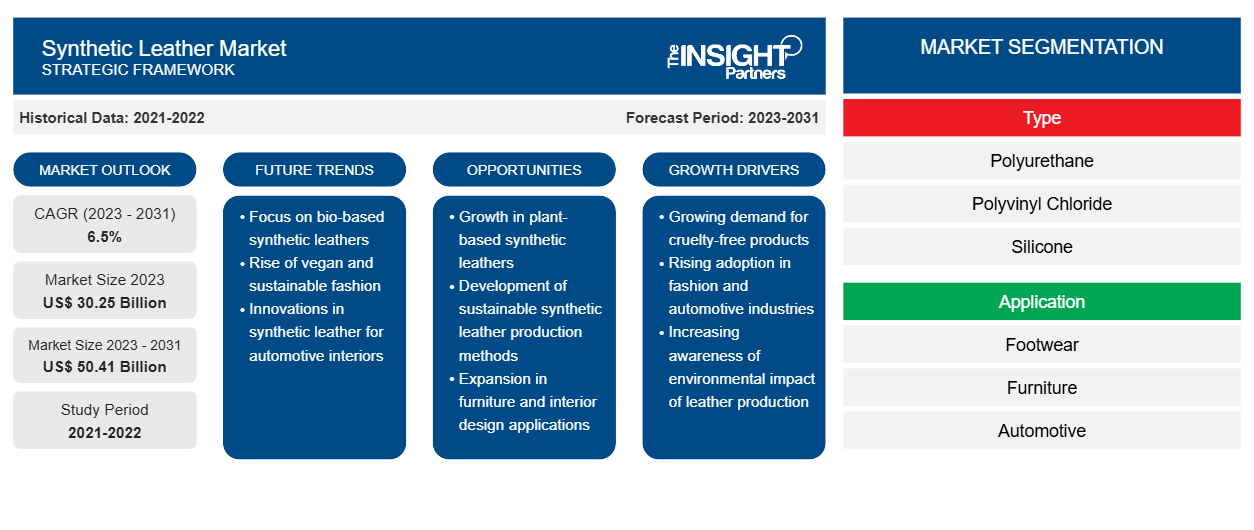Se proyecta que el tamaño del mercado de cuero sintético alcance los 50,41 mil millones de dólares estadounidenses para 2031, desde los 30,25 mil millones de dólares estadounidenses en 2023. Se espera que el mercado registre una CAGR del 6,5 % entre 2023 y 2031. Es probable que el creciente enfoque en el desarrollo de cuero de origen biológico siga siendo una tendencia clave en el mercado de cuero sintético.
Análisis del mercado del cuero sintético
El cuero sintético ha ganado popularidad en los últimos años. Se utiliza en diversas industrias, incluidas la del calzado, la indumentaria, el mobiliario y la automoción. El uso más común del cuero sintético es en la indumentaria, el equipaje y los estuches. El cuero sintético se utiliza cada vez más en chaquetas, abrigos, bolsos, carteras, cinturones, etc. El cuero sintético es adecuado para su aplicación en el calzado debido a su bajo coste y su resistencia a la abrasión.
Descripción general del mercado del cuero sintético
El cuero sintético se prepara mediante la extrusión de materias primas como cloruro de polivinilo, poliuretano, pigmentos de color, materiales de soporte y otros. Se espera que la creciente demanda de industrias como la del mueble, el calzado y la automoción impulse la demanda de cuero sintético. Además, se espera que las crecientes inversiones de los principales actores impulsen el crecimiento del mercado.
Personalice este informe según sus necesidades
Obtendrá personalización en cualquier informe, sin cargo, incluidas partes de este informe o análisis a nivel de país, paquete de datos de Excel, así como también grandes ofertas y descuentos para empresas emergentes y universidades.
- Obtenga las principales tendencias clave del mercado de este informe.Esta muestra GRATUITA incluirá análisis de datos, desde tendencias del mercado hasta estimaciones y pronósticos.
Factores impulsores y oportunidades del mercado del cuero sintético
Ventajas del cuero sintético
El cuero sintético ofrece varias ventajas. Refleja una apariencia visual con una calidad de cuero realista cuando se modifica y mejora. Es un material versátil disponible en una variedad de colores, acabados y patrones. El costo del cuero sintético es menor en comparación con el cuero genuino, lo que lo convierte en una opción mucho más asequible. Además, el cuero sintético es un material impermeable y puede resistir la penetración del agua, ya que consta de una capa base de plástico con un revestimiento de plástico. Como resultado, el cuero sintético es la opción perfecta para aplicaciones con exposición continua a la humedad. Por lo tanto, las ventajas asociadas con el uso del cuero sintético están impulsando el mercado.
Demanda creciente de la industria del calzado
La industria del calzado es uno de los segmentos más importantes de la industria del cuero sintético. La alta demanda de zapatos está brindando oportunidades para que la industria del calzado se desarrolle y crezca. El material de cuero sintético es adecuado para zapatos debido a su bajo costo y resistencia a la abrasión. Además, los zapatos de cuero sintético ofrecen excelentes cualidades impermeables. El cuero sintético se puede mezclar con algunos productos químicos para agregar características impermeables. Existe una gran demanda de cuero sintético en la industria del calzado. Además, muchas marcas de calzado se están enfocando en desarrollar zapatos de cuero de origen vegetal y zapatos de cuero vegano. Esto contribuye aún más a la alta demanda de cuero sintético. Por lo tanto, la creciente demanda de la industria del calzado crea oportunidades en el mercado del cuero sintético.
Informe de mercado de cuero sintético Análisis de segmentación
Los segmentos clave que contribuyeron a la derivación del análisis del mercado de cuero sintético son el aceite base, el tipo de producto y la industria de uso final.
- Según el tipo, el mercado del cuero sintético se divide en poliuretano, cloruro de polivinilo, silicona y otros. El segmento de poliuretano tuvo una mayor participación de mercado en 2023.
- Por aplicación, el mercado se divide en calzado, muebles, automoción, ropa, papelería y otros. El segmento del calzado tuvo la mayor participación del mercado en 2023.
Análisis de la cuota de mercado del cuero sintético por geografía
El alcance geográfico del informe del mercado de cuero sintético se divide principalmente en cinco regiones: América del Norte, Europa, Asia Pacífico, Europa, Medio Oriente y África, y América del Sur / América del Sur y Central.
La región de Asia Pacífico ha dominado el mercado del cuero sintético. El mercado del calzado de la región de Asia Pacífico está impulsado por la rápida urbanización, el crecimiento de la población y la industrialización en países como China, Indonesia e India. Además, la penetración de plataformas de comercio electrónico como Amazon y Alibaba ha facilitado la compra de calzado de manera conveniente por parte de los consumidores. Como resultado, la creciente demanda de la industria del calzado, la moda y la tapicería incluye una amplia variedad de artículos como zapatos y chaquetas, maletas y billeteras, e interiores de automóviles, en particular asientos, estuches para dispositivos electrónicos y sofás. Se prevé que la región de Asia Pacífico sea la de más rápido crecimiento en el próximo período.
Perspectivas regionales del mercado del cuero sintético
Los analistas de Insight Partners explicaron en detalle las tendencias y los factores regionales que influyen en el mercado del cuero sintético durante el período de pronóstico. Esta sección también analiza los segmentos y la geografía del mercado del cuero sintético en América del Norte, Europa, Asia Pacífico, Oriente Medio y África, y América del Sur y Central.

- Obtenga datos regionales específicos para el mercado de cuero sintético
Alcance del informe de mercado de cuero sintético
| Atributo del informe | Detalles |
|---|---|
| Tamaño del mercado en 2023 | US$ 30,25 mil millones |
| Tamaño del mercado en 2031 | US$ 50,41 mil millones |
| CAGR global (2023 - 2031) | 6,5% |
| Datos históricos | 2021-2022 |
| Período de pronóstico | 2023-2031 |
| Segmentos cubiertos | Por tipo
|
| Regiones y países cubiertos | América del norte
|
| Líderes del mercado y perfiles de empresas clave |
|
Densidad de actores del mercado del cuero sintético: comprensión de su impacto en la dinámica empresarial
El mercado del cuero sintético está creciendo rápidamente, impulsado por la creciente demanda de los usuarios finales debido a factores como la evolución de las preferencias de los consumidores, los avances tecnológicos y una mayor conciencia de los beneficios del producto. A medida que aumenta la demanda, las empresas amplían sus ofertas, innovan para satisfacer las necesidades de los consumidores y aprovechan las tendencias emergentes, lo que impulsa aún más el crecimiento del mercado.
La densidad de actores del mercado se refiere a la distribución de las empresas o firmas que operan dentro de un mercado o industria en particular. Indica cuántos competidores (actores del mercado) están presentes en un espacio de mercado determinado en relación con su tamaño o valor total de mercado.
Las principales empresas que operan en el mercado del cuero sintético son:
- Compañía Kuraray, Ltd.
- INDUSTRIA QUÍMICA SAN FANG CO., LTD.
- TEIJIN LIMITADA
- CORPORACIÓN DE PLÁSTICOS NAN YA
- Compañía FILWEL Co., Ltd.
- Alfatex Italia
Descargo de responsabilidad : Las empresas enumeradas anteriormente no están clasificadas en ningún orden particular.

- Obtenga una descripción general de los principales actores clave del mercado del cuero sintético
Noticias y desarrollos recientes del mercado del cuero sintético
El mercado del cuero sintético se evalúa mediante la recopilación de datos cualitativos y cuantitativos a partir de una investigación primaria y secundaria, que incluye publicaciones corporativas importantes, datos de asociaciones y bases de datos. A continuación, se incluye una lista de los avances del mercado:
- General Silicones (GS), un fabricante experto de productos de silicona con 50 años de experiencia, anuncia la disponibilidad de su nueva serie de productos de cuero vegano de silicona Compo-SiL® SL. La serie SL es adecuada para fabricantes de productos de consumo como bolsos y mochilas, zapatos, carteras, cinturones, encuadernaciones y fundas de libros que buscan suministros de cuero vegano con forro de tela aplicado en fábrica. (Fuente: General Silicones Co., Ltd., Noticias de la empresa, 2023)
Informe sobre el mercado del cuero sintético: cobertura y resultados
El informe “Tamaño y pronóstico del mercado de cuero sintético (2021-2031)” proporciona un análisis detallado del mercado que cubre las siguientes áreas:
- Tamaño del mercado y pronóstico a nivel global, regional y nacional para todos los segmentos clave del mercado cubiertos bajo el alcance
- Dinámica del mercado, como impulsores, restricciones y oportunidades clave
- Principales tendencias futuras
- Análisis detallado de las cinco fuerzas de Porter y FODA
- Análisis del mercado global y regional que cubre las tendencias clave del mercado, los principales actores, las regulaciones y los desarrollos recientes del mercado.
- Análisis del panorama de la industria y de la competencia que abarca la concentración del mercado, el análisis de mapas de calor, los actores destacados y los desarrollos recientes
- Perfiles detallados de empresas
- Análisis histórico (2 años), año base, pronóstico (7 años) con CAGR
- Análisis PEST y FODA
- Tamaño del mercado, valor/volumen: global, regional y nacional
- Industria y panorama competitivo
- Conjunto de datos de Excel
Informes recientes
Testimonios
Razón para comprar
- Toma de decisiones informada
- Comprensión de la dinámica del mercado
- Análisis competitivo
- Información sobre clientes
- Pronósticos del mercado
- Mitigación de riesgos
- Planificación estratégica
- Justificación de la inversión
- Identificación de mercados emergentes
- Mejora de las estrategias de marketing
- Impulso de la eficiencia operativa
- Alineación con las tendencias regulatorias





















 Obtenga una muestra gratuita para - Mercado de cuero sintético
Obtenga una muestra gratuita para - Mercado de cuero sintético